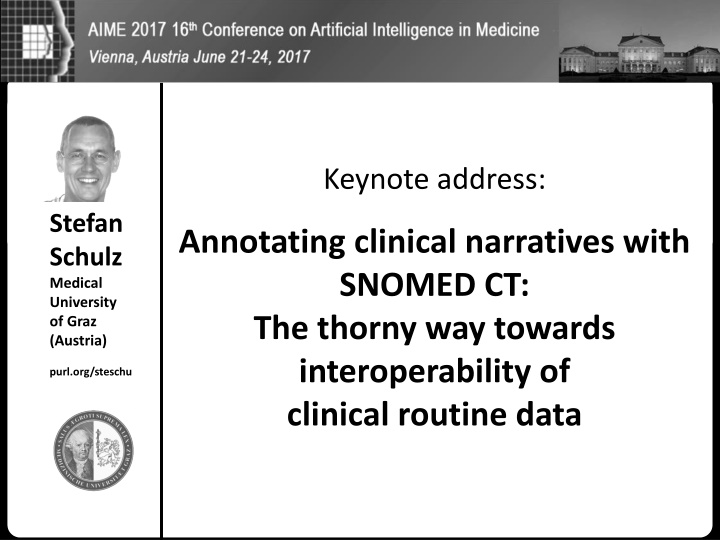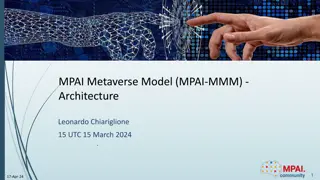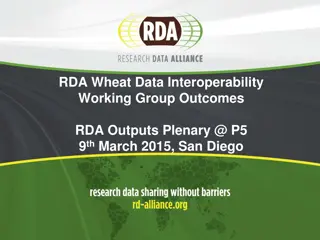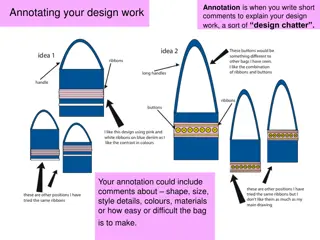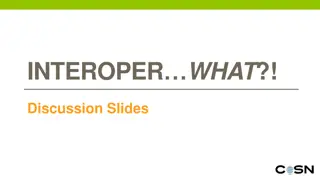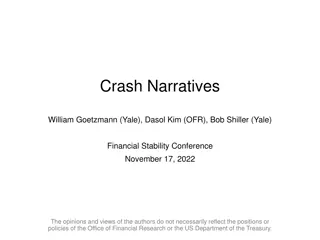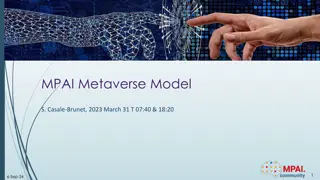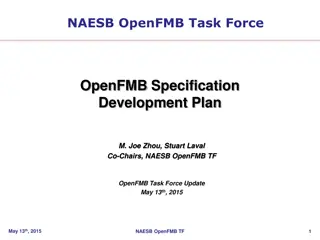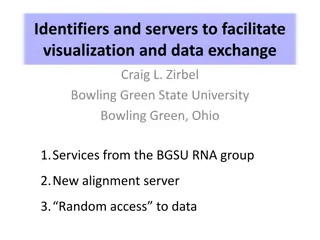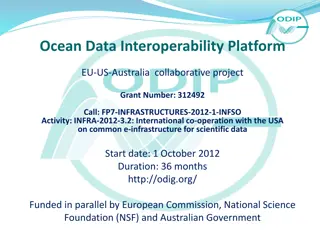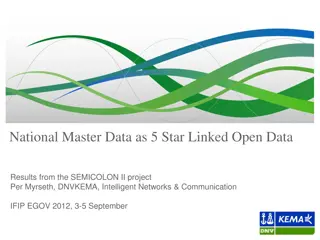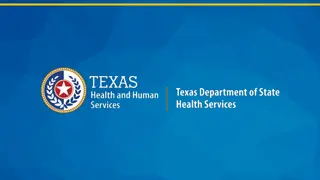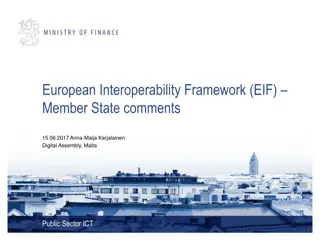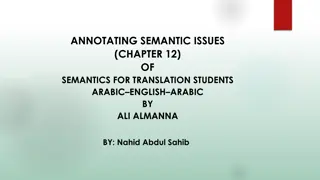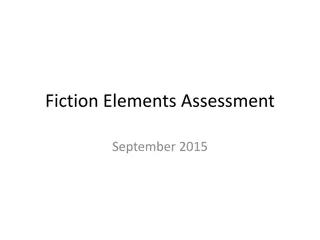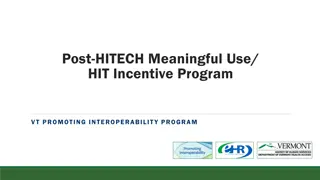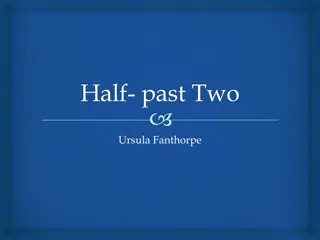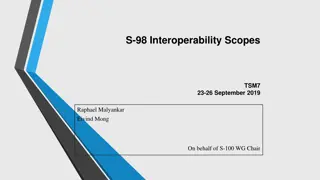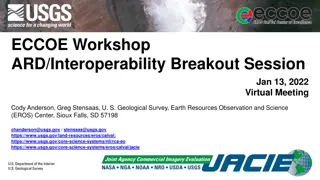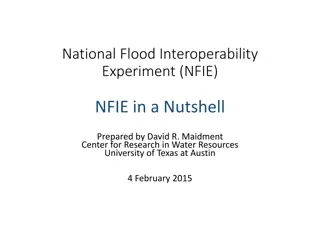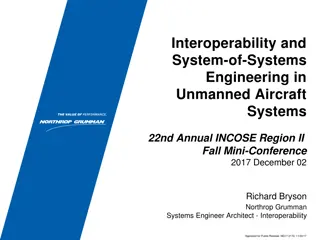Annotating Clinical Narratives for Interoperability
Annotating clinical narratives with SNOMED CT plays a crucial role in achieving interoperability of routine clinical data. This involves structuring unstructured data, ensuring reliability and agreement among annotators, and enhancing training data for better standards. The focus is on improving data reliability and interoperability through empirical studies and mechanisms to enhance agreement.
Download Presentation

Please find below an Image/Link to download the presentation.
The content on the website is provided AS IS for your information and personal use only. It may not be sold, licensed, or shared on other websites without obtaining consent from the author.If you encounter any issues during the download, it is possible that the publisher has removed the file from their server.
You are allowed to download the files provided on this website for personal or commercial use, subject to the condition that they are used lawfully. All files are the property of their respective owners.
The content on the website is provided AS IS for your information and personal use only. It may not be sold, licensed, or shared on other websites without obtaining consent from the author.
E N D
Presentation Transcript
Keynote address: Stefan Schulz Medical University of Graz (Austria) Annotating clinical narratives with SNOMED CT: The thorny way towards interoperability of clinical routine data purl.org/steschu
"Classical" AI workflow Data Represen- tation D Reasoning Output Acquisition
"Classical" AI workflow Reasoning A Output A Represen- tation Data D Acquisition Reasoning B Output B
"Classical" AI workflow Represen- tation A Reasoning Output A Data D Acquisition Represen- tation B Reasoning Output B
"Classical" AI workflow Data Represen- tation Acquisition A Reasoning Output A DA Data Represen- tation DB Acquisition B Reasoning Output B
Data reliability Data interoperability high Data DA Acquisition A DA=DB DA DB Data DB Acquisition B DA DB low
Data reliability Data interoperability unstructured representation structured representation high Inter- DA DA=DB pretation A Contrary to popular belief, Lorem Ipsum is not simply random text. It has roots in a piece of classical Latin literature from 45 BC, making it over 2000 years old. Richard McClintock, a Latin professor at Hampden-Sydney College in Virginia, looked up one of the more DA DB Inter- DB DA DB pretation B low
Focus of the talk Structured extracts from unstructured clinical data: reliability and interoperability Empirical study on inter-annotator agreement Analysis of examples for inter-annotator disagreement Mechanisms to improve agreement better data reliability better interoperability better training data better gold standards
Annotating clinical narratives with SNOMED CT Coding observation map metadata configurations phenomena observed Vocabulary Annotation map Contrary to popular belief, Lorem Ipsum is not simply random text. It has roots in a piece of classical Latin literature from 45 BC, making it over 2000 years old. Richard McClintock, a Latin professor at Hampden-Sydney College in Virginia, looked up one of the more metadata configurations symbols (configurations) symbolic representation
Annotating clinical narratives with SNOMED CT eHealth standard, maintained by transnational SDO Huge clinical reference terminology ~300,000 "concepts" representable as OWL EL preferred terms and synonyms in several languages SNOMED CT (quasi-) ontological definitional and qualifying axioms covers disorders, procedures, body parts, substances, devices, organisms, qualities multiple hierarchies
Annotation: Sources of complexity Contrary to popular belief, Lorem Ipsum is not simply random text. It has roots in a piece of classical Latin literature from 45 BC, making it over 2000 years old. Richard McClintock, a Latin professor at Hampden-Sydney College in Virginia, looked up one of the more SNOMED CT Map Clinical narrative - sequence of Tokens - syntactic structures - relations at various levels Terminology - preferred terms - synonyms - definitions Ontology - entities, codes - relations - logical constructors - axioms Ill-defined concepts Similar concepts Pre-coordination vs. post- coordination Compactness Agrammaticality Short forms Implicit contexts best text span to annotate? Na ve or analytic annotation? Complex annotations (> 1 concept) Degree of formality?
Examples Clinical text SNOMED CT concepts (FSNs) 'Duodenal structure (body structure)' " the duodenum . 'Mucous membrane structure (body structure)' ? The mucosa is " 'Duodenal mucous membrane structure (body structure)' 'Traffic accident on public road (event)' " Hemorrhagic shock ? 'Traffic accident on public road (event)', 'Renal tubular acidosis (disorder)' after RTA " ? 'Traffic accident on public road (event)' or 'Renal tubular acidosis (disorder)' 'Suspected dengue (situation)' " travel history of 'Suspected (qualifier value)' suspected dengue " 'Dengue (disorder)'
Coding / Annotation guidelines Examples: 1. German coding guidelines for ICD and OPS, 171 pages 2. Using SNOMED CT in CDA models: 147 pages 3. CHEMDNER-patents: annotation of chemical entities in patent corpus: annotation manual 30 pages 4. CRAFT Concept Annotation guidelines: 47 pages 5. Gene Ontology Annotation conventions: 7 pages Complex rule sets, requiring intensive training 1. http://www.dkgev.de/media/file/21502.Deutsche_Kodierrichtlinien_Version_2016.pdf 2. http://www.snomed.org/resource/resource/249 3. http://www.biocreative.org/media/store/files/2015/cemp_patent_guidelines_v1.pdf 4. http://bionlp-corpora.sourceforge.net/CRAFT/guidelines/CRAFT_concept_annotation_guidelines.pdf 5. http://geneontology.org/page/go-annotation-conventions
Annotation experiments in ASSESS-CT EU project on the fitness of purpose of SNOMED CT as a core reference terminology for the EU: www.assess-ct.eu Feb 2015 Jul 2016 Scrutinising clinical, technical, financial, and organisational aspects of reference terminology introduction Summary of results: brochure published, scientific papers to appear http://assess-ct.eu/fileadmin/assess_ct/final_brochure/assessct_final_brochure.pdf
Annotation of clinical narratives Nitroglycerin pump spray as required Amantadine bds Allopurinol 300 tablet every other day (last dose on 20091130) Mefenamic acid 500 mg up to 3x daily for pain in conjunction with simultaneous administration of a drug to protect the stomach e. g. Pantoprazole 40mg. Torasemide bds Melperone 50 mg p. m. pre-coordinated codes understanding text and assign maximally specific codes 387404004;385074009;225 761000 372763006;229799001 387135004;385055001;225 760004 Comparing SNOMED CT vs. UMLS derived terminology Resources Parallel corpus: 60 clinical text snippets from 6 languages, high diversity For each language: 2 annotators * 40 samples 20 snippets annotated twice Annotators trained by webinars follow annotation guideline (10 pages) e.g. chunking into noun phrases annotation of chunks by sets of codes give preference to maximally 387185008;258684004; 229798009;22253000 79970003;416118004; 373517009;69695003 395821003;258684004 318034005;229799001 442519006;258684004; 422133006 11163003;245543004; 123851003 263172003;263156006; 260528009 7 Intact teeth are in the mouth. Fractures are visible on the medians of Mandible and Maxilla the fragments are dislocated. 123735002 Normal mucous membranes in mouth pharynx and on the larynx. Hyoid and thyroid cartilage are intact. Fragmental fractures of the two upper vertebrae of the cervical spine. Otherwise the cervical spine is intact. Oesophagus as well as trachea are torn at the lower end of the neck. 17621005;33044003; 71248005 21387005;52940008; 11163003 13321001;207984009; 207983003 122494005;11163003 262793000;282459005; 261122009;123958008
Principal quantitative results (English) Concept coverage [95% CI] SNOMED CT Alternative Text annotations English .86 [.82-.88] .88 [.86-.91] Term coverage [95% CI] SNOMED CT .68 [.64; .70] Alternative .73 [.69; .76] Text annotations English Inter annotator agreement Krippendorff's Alpha [95% CI] SNOMED CT Alternative Text annotations .37 [.33-.41] .36 [.32-.40] Krippendorff, Klaus (2013). Content analysis: An introduction to its methodology, 3rd edition. Thousand Oaks, CA: Sage.
Agreement map: text annotations (English) SNOMED CT UMLS SUBSET green: agreement yellow: only annotated by one coder red: disagreement
Systematic error analysis Creation of gold standard for SNOMED CT 20 English text samples annotated twice 208 NPs Analysis of English SNOMED CT annotations by two additional terminology experts Consensus finding, according to pre-established annotation guidelines Inspection, analysis and classification of text annotation disagreements Presentation of some disagreement cases for SNOMED CT
Human issues Lack of domain knowledge / carelessness Tokens Annotator #1 Annotator #2 Gold standard 'Structure of abductor hallucis muscle (body structure)' 'Abducens nerve structure (body structure) ' 'Abducens nerve structure (body structure)' "IV" Retrieval error (synonym not recognised) Tokens Annotator #1 Annotator #2 Gold standard "Glibenclamide"'Glyburide 'Glyburide (substance)' (substance)' Non-compliance with annotation rules
Ontology issues (I) Polysemy ("dot categories")* Tokens Annotator #1 Annotator #2 Gold standard 'Malignant lymphoma (disorder)' 'Malignant lymphoma - category (morphologic abnormality)' 'Malignant lymphoma (disorder)' 'Lymphoma" *Alexandra Arapinis, Laure Vieu: A plea for complex categories in ontologies. Applied Ontology 10(3-4): 285-296 (2015)
Ontology issues (I) Polysemy ("dot categories")* Tokens Annotator #1 Annotator #2 Gold standard 'Malignant lymphoma (disorder)' 'Malignant lymphoma - category (morphologic abnormality)' 'Malignant lymphoma (disorder)' 'Lymphoma" "Pseudo-polysemy" Incomplete definitions Tokens Annotator #1 Annotator #2 Gold standard 'In the past (qualifier value)' 'History of (contextual qualifier) (qualifier value)' "Former 'Ex-smoker (finding)' Smoker" 'Smoker (finding)' 'Smoker (finding)' *Alexandra Arapinis, Laure Vieu: A plea for complex categories in ontologies. Applied Ontology 10(3-4): 285-296 (2015)
Ontological issues (II) Incomplete definitions Tokens Annotator #1 Annotator #2 Gold standard 'Skeletal muscle structure (body structure)' 'Muscle finding (finding)' "Motor: 'Skeletal muscle normal (finding)' normal bulk and tone" 'Normal (qualifier value)' 'Normal (qualifier value)'
Ontological issues (II) Normal findings, incomplete definitions Tokens Annotator #1 Annotator #2 Gold standard 'Skeletal muscle structure (body structure)' 'Muscle finding (finding)' "Motor: 'Skeletal muscle normal (finding)' normal bulk and tone" 'Normal (qualifier value)' 'Normal (qualifier value)' Fuzziness of qualifiers Tokens Annotator #1 Annotator #2 Gold standard 'Severe (severity modifier) (qualifier value)' 'Significant (qualifier value)' 'Moderate (severity modifier) (qualifier value)' "Significant bleeding" 'Bleeding (finding)' 'Bleeding (finding)' 'Bleeding (finding)'
Interface term (synonym) issues Tokens Annotator #1 Annotator #2 Gold standard "Blood 'Blood (substance)' 'Hemorrhage (morphologic abnormality)' 'Hemorrhage (morphologic abnormality)' 'Extravasation (morphologic abnormality)' extravasati on" "extravasation of blood"
Interface term (synonym) issues Tokens Annotator #1 Annotator #2 Gold standard "Blood 'Blood (substance)' 'Hemorrhage (morphologic abnormality)' 'Hemorrhage (morphologic abnormality)' 'Extravasation (morphologic abnormality)' extravasati on" "extravasation of blood" Tokens Annotator #1 Annotator #2 Gold standard "anxious" 'Anxiety (finding)' 'Worried (finding)' 'Anxiety (finding)' "anxious cognitions"
Language issues Ellipsis / anaphora "Cold and wind are provoking factors." (provoking factors for angina) "These ailments have substantially increased since October 2013" (weakness) "No surface irregularities" (breast) "Significant bleeding" (intestinal bleeding) Ambiguity of short forms "IV" (intravenous? Fourth intracranial nerve?) Co-ordination: "normal factors 5, 9, 10, and 11" Scope of negation "no tremor, rigidity or bradykinesia" Addressed by annotation guideline Manageable by human annotators Known challenges for NLP systems
Prevention and remediation of annotation disagreements
Prevention: annotation processes Training with continuous feedback Early detection of inter annotator disagreement triggers guideline enforcement / guideline revision Tooling Optimised concept retrieval (fuzzy, substring, synonyms) Guideline enforcement by appropriate tools Postcoordination support (complex syntactic expessions instead of grouping of concepts Anti-patterns, e.g. avoid unrelated primitive concepts (?)
Prevention: improve terminology structure Fill gaps equivalence axioms (reasoning) Self-explaining labels (FSNs), especially for qualifiers Scope notes / text definitions where necessary Manage polysemy Flag navigational and modifier concepts Strengthen ontological foundations Upper-level ontology alignment Clear division between domain entities and information entities Overhaul problematic subhierarchies, especially qualifiers
Prevention: improve content maintenance Analysis of real data to support terminology maintenance process Harvest notorious disagreements between text passages and annotations from clinical datasets Compare concept frequency and concept co-occurrence between comparable institutions and users to detect imbalances Stimulate community processes for ontology- guided content evolution: Crowdsourcing of interface terms by languages, dialects specialties, user groups (separation of interface terminologies from reference terminologies is one of the ASSESS-CT recommendations)
Remediation of annotation disagreements Exploit ontological dependencies / implications Concept A 'Mast cell neoplasm (disorder)' Concept B 'Mast cell neoplasm (morphologic abnormality)' 'Isosorbide dinitrate (substance)' Dependency A subclassOf AssociatedMorphology some B 'Isosorbide dinitrate' (product)' 'Palpation (procedure)' 'Palpation - action A subclassOf HasActiveIngredient some B A subclassOf Method some B (qualifier value)' 'Blood pressure (observable entity)' 'Increased (qualifier value)' 'Heart rate (observable entity)' 'Blood pressure taking (procedure)' 'Increased size (finding)' 'Finding of heart rate (finding)' A subclassOf hasOutcome some B A subclassOf isBearerOf some B A subclassOf Interprets some B
Experiment Gold standard expansion: Step 1: include concepts linked by attributive relations: A subclassOf Rel some B Step 2: include additional first-level taxonomic relations: A subclassOf B Language of text sample Gold standard expansion F measure 0.28 no expansion 0.28 English expansion step 1 0.29 expansion step 2 only insignificant improvement possibly due to missing relations in SNOMED CT, e.g. haemorrhage - blood
Conclusion (I) Low inter-annotator agreement limits successful use of clinical terminologies / ontologies for manual annotation scenarios for benchmarking of NLP-based annotations for optimised training data for ML Structured data essential for many intelligent systems, but unreliable information extracted from clinical narratives raises patient safety issues when used for decision support
Conclusion (II) Prevention of disagreements Education, tooling, guideline support Terminology content improvement: labelling, scope notes, ontological clarity, full definitions, community processes High coverage interface terminologies Remediation of disagreements So far no clear evidence of ontology-based resolution of agreement issues Big data approaches ?
Conclusion (III) R & D required: "Learning systems" for improvement terminology content / structure / tooling. Clinical "big data" underused resource Harmonization of annotation guideline creation and validation efforts Formulate and enforce good quality criteria for clinical terminologies used as annotation vocabularies Better ontological underpinning of clinical terminologies Ontologically founded patterns for recurring clinical documentation tasks: Information extraction rather than concept mapping* *Mart nez-Costa C et al. Semantic enrichment of clinical models towards semantic interoperability. JAMIA 2015 May;22(3):565-76
Thanks for your attention Slides will be accessible via at purl.org/steschu Acknowledgements: ASSESS CT team: Jose Antonio Mi arro-Gim nez, Catalina Mart nez- Costa, Daniel Karlsson, Kirstine Rosenbeck G eg, Korn l Mark , Benny Van Bruwaene, Ronald Cornet, Marie-Christine Jaulent, P ivi H m l inen, Heike Dewenter, Reza Fathollah Nejad, Sylvia Thun, Veli Stroetmann, Dipak Kalra Contact: stefan.schulz@medunigraz.at
Vibhu Agarwal, Tanya Podchiyska, Juan M. Banda, Veena Goel, Tiffany I. Leung, Evan P. Minty, Timothy E. Sweeney, Elsie Gyang, Nigam H. Shah: Learning statistical models of phenotypes using noisy labeled training data. JAMIA 23(6): 1166- 1173 (2016)
